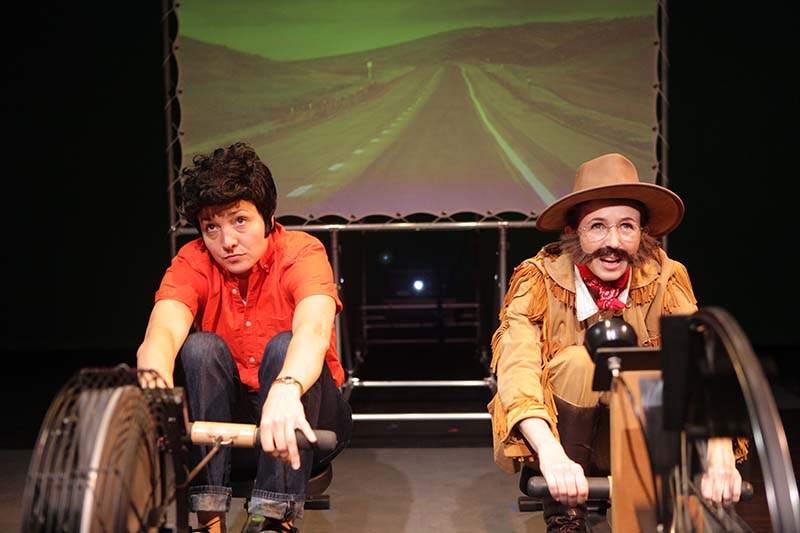Review: UMS presents 'Layla and Majnun,' Mark Morris Dance Group & The Silk Road Ensemble
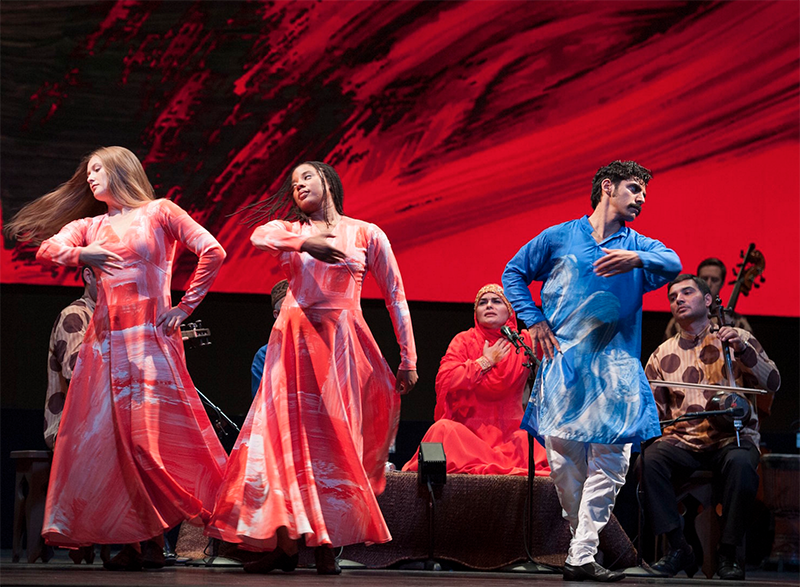
Choreographer Mark Morris notes that the ancient story of Layla and Majnun presented by UMS at the Power Center this weekend -- a Persian romance retold across the Mid-East since the 12th-century -- is one of profound, abundant, eternal love, and that a full staging of it has the potential to make it more accessible to a larger audience. Given the western penchant for a good tragic love story -- think Romeo and Juliet -- this tale of young lovers so desperate for each other that the man is driven mad certainly has potential cultural traction here. With his production of Layla and Majnun, Morris succeeds in bringing this story to life for audiences who may be unfamiliar with it and in so doing adds his distinct mark to a tale that has already had many hands on it.
Consider all the permutations of this ancient tale that are present in Morris’s production. Its musical source is a 1908 Azerbaijani opera, Leyli and Majnun, that in turn is based on a 16th-century poetic setting of the ancient story. The opera was the first instance of western symphonic music combined with mugham¸ a traditional Azerbaijani improvisational form performed by vocalists accompanied by frame drums, lute, and spike fiddle. Although the opera is beloved in Azerbaijan, it has been reconceived for this production. Renowned mugham singer Alim Quasimov, in collaboration with the Silk Road Ensemble, has compressed the three-and-a-half-hour opera into a more easily digestible seventy minutes, distilled around Majnun’s solos and his duets with Layla. Furthermore, elements that were kept separate in the original opera - mugham and western instruments, improvisation and written parts - are here integrated. To this story many times retold and this music many times re-imagined, Morris adds his dancing.
The musicians - Qasimov and his daughter, Fargana Qasimova, with the Silk Road Ensemble - fill the center of the stage while the dancers weave around and between them. The story unfolds in five acts: Love and Separation, The Parents’ Disapproval, Sorrow and Despair, Layla’s Unwanted Wedding, and The Lover’s Demise.
The tone of the verses, present as a libretto in the printed program, is sustained, seldom varying even as the story progresses from act to act. The lovers continuously profess their agonized passion, but Morris’s choreography refracts this one-noted desperation. In Act I, Layla and Majnun glow with smiles. They rebound from broad and deep pliés and extend glorious legs, testing their connection with one another from different angles and at different distances across the stage. They play a little game, encircling each other with their arms. This merry interaction directly contrasts the verses of Act I - “My heart is heavy because I am alone…I feel like a nightingale that cries in pain…” In so doing, it creates a satisfying starting place; theatrically, the story has somewhere to go.
The dancing also adds breadth to the characters. The full cast of twelve is almost always on stage, but different dancers take on the roles of Layla and Majnun in each of the first four acts. The different aspects of these characters that emerge over time and through circumstance are made evident by the different humans who embody them. Stacy Martorana’s Layla of Act I is exuberant and expansive, whereas Nicole Sabella’s Act II Layla becomes more restrained.
With the work of story-telling done by the printed libretto (and largely superfluous projected supertitles), Morris’s choreography only occasionally employs mime-like “literal” movement: Layla’s unwanted husband shakes his fist at Majnun, or Layla reaches longingly toward her lover. More often, the dancing relies on a more visceral meaning-making: as Majnun goes mad, he pitches backward with knees bent deep and arms spread wide. When her parents disapprove, Layla curtsies low and slow, her fingers and wrists tracing sinuous curlicues, but then finds herself standing high on a step, pushing the air away from her. As Layla’s Unwanted Wedding unfolds, the stage is flanked by rows of unison dancers whose pert and precise footwork and shifting facings manage to evoke both a folk dance and the inevitability of tradition and ceremony.
Sometimes, as with that wedding scene, the ensemble of dancers is a community. They herd the lovers away from each other, or watch and seem to whisper about them. Sometimes they play the role of a Greek chorus, commenting on or translating the actions of the central characters. In Sorrow and Despair, they stand linked together, heads whipping and rolling from side to side, on and on, creating a frenzy of obsession. Sometimes they are all Laylas and all Majnuns, reflecting the actions of the “real” Layla and Majnun.
The resolution of Layla and Majnun’s desperate affair is, of course, death. In the final act, all four Laylas and all four Majnuns are present, but their respective demises seem asymmetric. My impression is of all the Laylas descending together to sit with bowed heads, but each Majnun has a brief solo before surrendering to the floor. (After all, the story tells that it’s Majnun who officially goes crazy; Layla just expires.) A clarinet solo draws all the dancers up to their feet, and each pair of Layla and Majnun meets briefly before exiting. I want to think they have been united in death, or that their earthly love has been subsumed in a divine one, but the final image is of a pair of female dancers returning to extinguish two of the lanterns that have been burning throughout the performance.
If there’s a shortcoming in the production, it lies with an uneven distribution of restraint. In comparison to the wildness, the near-hysteria, of the singers’ improvised solos, the choreography sometimes seems safe, tame, comparatively unimpassioned. Perhaps it’s a function of spatial confinement; the Silk Road musicians and mugham singers take up a good chunk of the stage and the dancers have only limited paths available. Or maybe it’s the nature of the rehearsed versus the spontaneous; when each of the Majnuns performed his last, brief solo, I glimpsed an unleashing that paralleled that of the singers’ and I suspect it’s because those solos are largely improvisatory. Mine is a small complaint, though; this Layla and Majnun is a worthy installment in the story’s evolving history as a performance work. Its reconceived music and eloquent dancing serve the famous story and render it quite legible to a non-Azerbaijani audience.
From 1993-2004, Veronica Dittman Stanich danced in New York and co-produced The Industrial Valley Celebrity Hour in Brooklyn. Now, PhD in hand, she writes about dance and other important matters.
Layla and Majnun continues through Saturday, October 15 at the Power Center, 121 Fletcher St., Ann Arbor. For more information and tickets, visit: http://ums.org/performance/layla-and-majnun/.
Review: U-M production finds perfection in nostalgic ‘Drowsy Chaperone’
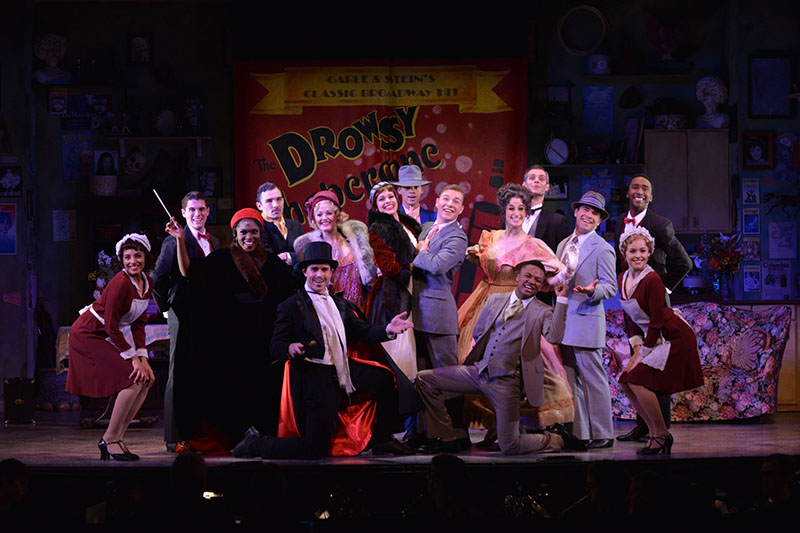
A man with gray flecked hair, dressed in an old cardigan sweater sits in the dark complaining about modern theater and modern life in general. Things just ain’t what they used to be.
This is the beginning of magic, a near perfect production of The Drowsy Chaperone by the University of Michigan Department of Musical Theatre.
The man in the chair is sharing his weary view of the world and his obsession with a recording of a 1928 musical, from back in the day when musicals were fun. That musical, The Drowsy Chaperone, is a fizzy, frivolous fluff with the usual stock characters, thin and predictable plot, jazz inspired score and a fine example to the man in the chair of all the sweetness that has been lost in the world.
As the man tells us the story of the musical, the musical comes vividly to life in his nostalgia filled apartment. He swoons over every nuance of story and every piece of stage business and recounts the back stories for all the original stars, rising diva and fading diva, vaudeville comedy team and notorious womanizer, secretly gay leading man and charming old pros who have seen better days.
Director Mark Madama has assembled a terrific cast, each perfectly fit to the character they play. The style is arch, satirical but never so overplayed that it loses touch with what might have been a smashing opening night on Broadway those many years ago. The Drowsy Chaperone, with music and lyrics by Lisa Lambert and Greg Morrison and book by Bob Martin and Don McKellar, uses that happy style of musical theater to poke fun at nostalgia but also offer an ode to entertainment for entertainment’s sake.
The 1928 play concerns the romance of a Broadway star and a businessman, their impending marriage, the star’s woozy “chaperone,” a couple of bakers (who are really gangsters), a producer afraid of losing his star, a chorus girl angling to take her place, a Latin lover, a dotty lady and her droll “underling.” Sound familiar? And every piece goes together like clockwork. Every performance is choice.
Hannah Lynne Miller is the effervescent Janet Van de Graaff, the star about to throw away the spotlight for marriage. Miller is a riot as she poses for the press, sputters between devotion for her new beau and anxiety over losing her celebrity fix. She’s a fine singer who delivers sincerity even on a song that the man in the chair warns has awful lyrics.
Equally compelling is Nkeki Obi-Melekwe as the title character, the chaperone. She is a deft comedian, with arched eyes and pained sophistication. Her singing shows great range and precise, sensitive phrasing needed to deliver all the humor and sly emotion of her “anthem” “As We Stumble Along.”
Charlie Patterson is hilarious as the egotistic, posturing Adolpho, self-styled Latin lover. He has a love song to himself “I Am Adolpho” that he delivers with just the right amount of clueless self-congratulation.
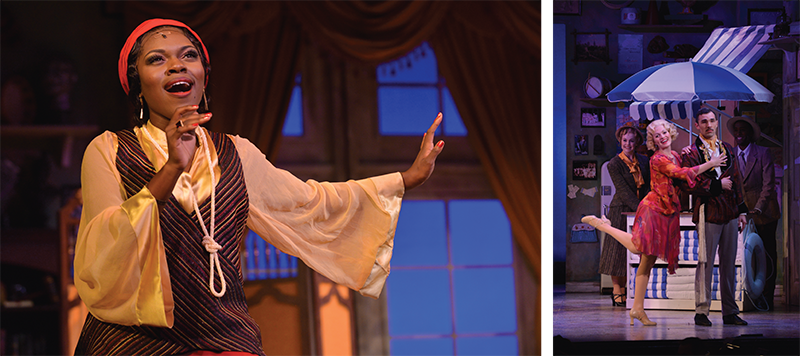
Kyle McClellan as the potential groom matches the self-loving ego of his bride to be with comic charm. But he also sings and dances superbly. McClellen and Christopher Campbell as his diligent best man perform a great tap dance routine to the song “Cold Feet.”
The tap dance is interrupted by the underling, a butler in the tradition of P.G. Wodehouse’s Jeeves, always one step ahead of the upper crusty. Aidan Ziegler-Hansen delivers his lines with precision timing and a bit of droll disdain. He also goes a mean little tap dance.
His usual partner is the ever-confused Mrs. Tottendale, played by Isbel Stein. Stein is amusingly spacey, dressed in a long-dated dress to match her bafflement. She and Ziegler-Hansen sing a goofy love song, “Love is Always Lovely in the End.”
Riley McFarland is the producer, a man in a constant state of despair as he is hounded by gangsters and a pushy chorine. He brings a bit of authority to a funny character. Jo Ellen Pellman plays Kitty, the “dumb blonde” stereotype, to a tee. Her voice cracks, her eyes roll, her body shimmies. It all works.
What also works is the clockwork timing of Joseph Sammour and Simon Longnight as the comic gangsters in both their comic wordplay (a stereotype of ’20s musicals) and their dizzy dance number “Toledo Surprise.”
Another post Lindbergh element to musicals of those days was an aviator, but here an aviatrix with a booming singing voice, well played by Cydney Clark.
The heart and soul of this production is Alexander Sherwin, that man in the chair. His voice may remind you of David Sedaris, a hint of sadness behind every laugh line. Sherwin takes us deep into this man who loves the theater and hates what has happened to it. He knows the story of every performer, the way kids know the story behind sports figures and rappers. He harbors ill will to the modern world and slowly, surely we find out why. Sherwin’s performance is impeccable and gives this bit of fluff its deeper meaning.
The musical direction and the jazz style orchestra under Jason DeBord is outstanding, especially in its ability to give punctuation to the humor on stage. Mara Newbery Greer’s choreography is terrific whether handing the lively tap numbers, a tricky skate routine or the ensemble in full motion.
Caleb Levengood’s set is a masterful tribute to nostalgia, a green colored parlor covered with star photos, posters and playbills and the comfy furniture of another era. The set is also well suited to the quick scene changes of the musical within the play. But there are some subtle touches that get at the heart of the man in the chair, like a row of pill bottles on his side table.
This is a big show, full of humor within the musical and at the expense of the musical. This is an ode to the giddy, goofy '20s musical in all its glory and the UM production grabs all that humor and goes deep into back story for a little more. Bravo!
Hugh Gallagher has written theater and film reviews over a 40-year newspaper career and was most recently managing editor of the Observer & Eccentric Newspapers in suburban Detroit.
The Drowsy Chaperone continues at the Lydia Mendelssohn Theatre Friday through Sunday Oct. 14-16 and Thursday-Sunday Oct. 20-23. For tickets call the box office at (734)764-2538 or go online to http://tickets.music.umich.edu.
Preview: Theatre Bizarre: The Greatest Masquerade on Earth
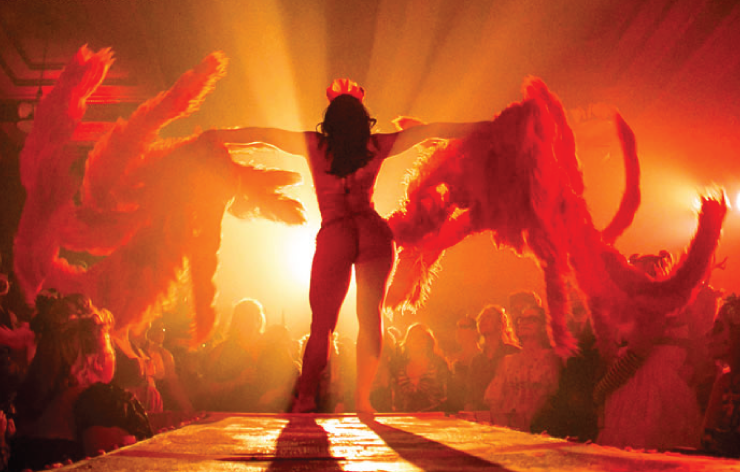
Theatre Bizarre, the "greatest masquerade on earth," returns to the Masonic Temple in Detroit this month for elaborate, extravagant, eerie debauchery. The annual event has grown in size enormously since its origin as essentially a backyard Halloween party 17 years ago and now takes place across eight floors of the Masonic. The brainchild of mastermind John Dunivant, Theatre Bizarre previously took place in an abandoned area near the Michigan State Fairgrounds before being unceremoniously shut down by city officials in 2010 (before that, they’d been kicked out of the Russell Industrial Complex). Now completely legal, the Masonic seems to be the perfect home for the event, and this year, for the first time, organizers have expanded it to take place across two weekends rather than just one.
Part circus, part carnival, part burlesque and fetish show, and part, yes, masquerade, Theatre Bizarre is unlike most parties taking place this time of year. Illusionists, carnival acts, dancers, musicians, and spontaneous theatrics greet attendees around every turn, along with mind-bendingly detailed scenery and exhibitions. Last year, a "Ghost Train," lit by a single strobe light and conducted by a silent masked man, took guests on a careening mini-roller coaster ride around the Masonic's foggy seventh floor, while several floors below, burlesque dancers emerged from the mouth of a giant devil and strutted down a long catwalk. Elsewhere, taxidermy animals held court over long buffet tables, mimes and jugglers moved among the crowd, and acrobats leaped over furniture. The Grand Ballroom is often the largest room at the Bizarre, and in previous years has been filled with an array of carnival games, treat stands and sideshow performances, including an ice cream shop serving Theatre Bizarre-inspired flavors.
Attendees are required to come in costume; in fact, you'll be turned away at the door with no refund if you show up in street clothes. Costumes run the gamut from homemade affairs, cobbled together from secondhand store finds to expensive, custom-ordered creations. You won't find Captain America or Minnie Mouse wandering around Theatre Bizarre either; the emphasis is on costumes that are weird, satanic, sexy, occult, eerie and/or decadent.
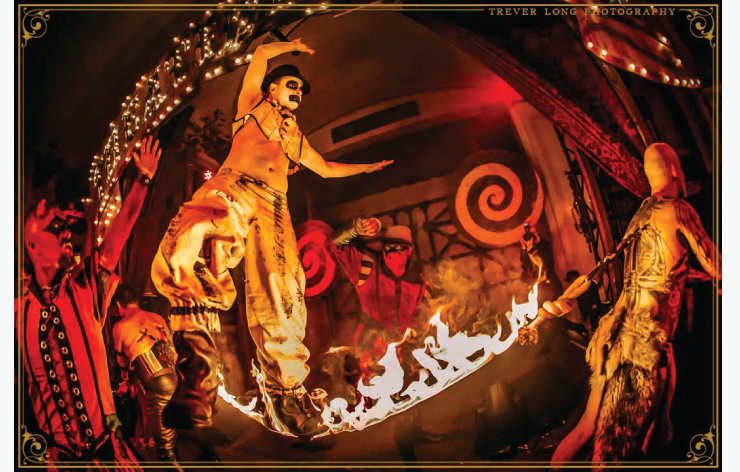
There are four separate Theatre Bizarre events this year, two Gala Masquerades on Fridays and two Historic Theatre Bizarres on Saturdays. The more expensive Gala Masquerade is a formal masquerade ball with a maximum attendance of only 450 people. Dinner and drinks are included in the ticket price, and formal attire, along with masks that conceal one's identity are a must. Guests can enjoy a cocktail reception, strolling dinner, pockets of entertainment around the Masonic, and dancing. The main Theatre Bizarre event takes place on Saturdays, and is less formal, although many still include masks in their costumes. This event is much larger, with attendance pushing 2,000, 5 separate main stages, and 20 performance areas, all of which remain active until the event closes at 4 am.
Theatre Bizarre is particularly unique for its lack of corporate sponsors. Dunivant and those he works with to create the event are artists, and don’t want logos interrupting the world they create or jolting visitors back to reality. Putting the event on at the Masonic is no easy feat: not only do sets and architectural features need to be built elsewhere and reassembled on site, but the wiring in the building is so old that Dunivant and his co-creators run the risk of frying it if they used it to support the electrical demands of the show. Instead, cables and wiring—thousands of feet of them—have to be routed through back hallways, walls, and vents. But Dunivant keeps making it happen every year, and hundreds of devoted attendees are glad. Still, who knows how much longer they’ll be able to pull off this outrageous event, so if there’s ever a year to go experience the magic, this is surely it.
Elizabeth Pearce is a Library Technician at the Ann Arbor District Library. She is super excited to wear a giant horned headdress to Theatre Bizarre this year.
Theatre Bizarre takes place October 14-15 and October 21-22 at the Masonic Temple in Detroit. Tickets range from $95-$260 and can be purchased online, where you can also find out more information about the event.
Review: The Purple Rose's Morning After Grace Is a Hilarious and Sensitive Comic Drama

Growing old can be hell but it can also be hilarious as proven by the Purple Rose Theatre Company’s World Premiere presentation of playwright Carey Crim’s Morning After Grace.
Crim’s meditation on aging, marriage and sexual frustration is in the superb hands of director Guy Sanville. A three-actor cast handles the unforced and sparkling humor with the precision of a well-disciplined string quartet while also letting it all out when the humor turns to a cathartic sadness.
The scene is a wealthy retirement community on Amelia Island, Florida. An older but still handsome man stumbles from his bedroom into his living room with all the evidence of a head-splitting hangover. He plops on a couch with a look of bewildered exhaustion and falls into a light sleep. Suddenly, a head pops out from a tangled comforter. A woman’s face peeks out and a giddy, happy grin spreads across her face.
In this small opening we immediately understand the dynamic that will play out in Crim’s play. These two characters were strangers to each other just a day before. They’ve had a night at the man’s condominium. Their very different personalities will delight, challenge and comfort each other over a momentous morning.
The title is a pun. Grace refers both to the religious meaning of divine favor but it also refers to the man’s now-deceased wife, whose funeral is the catalyst for what ensues. In this production, it also could refer to the grace and style of the three performers.
Michelle Mountain is Abigail. Her beaming entrance is a clue to Abigail’s attempts to keep a happy mood as she navigates her way through her mid-60s after a divorce. Mountain is a gifted actress. She is as adept at physical comedy, which she demonstrates with some creative costume changes, as she is with fast repartee. She has an expressive face that can light up with delight and also display deep sympathy. Her Abigail seems to have it all together as a professional grief counselor until bit by bit we learn of her insecurity. But she’s an optimist and sweet-natured, a perfect foil to the stranger she went home with.
Randolph Mantooth is Angus, Abigail’s emotional opposite. He’s a young-looking 70-year-old with some unsettled business with his late wife. But he has long been a taciturn, cynical and angry man. This comes through in some sharp barbs that Mantooth delivers with droll precision. Mantooth’s gruff demeanor has a shaggy dog quality that promises that his bark in worse than his bite, even when things get a bit rough. He seems to be getting the upper hand in his byplay with Abigail, but things take an unusual turn.
Ollie enters the scene. Ollie is another resident at the community. He’s a 66-year-old former Detroit Tiger and Grace’s friend. Played by Lynch Travis, a big man who brings big warmth to the character of Ollie, he could seem menacing, but is really gentle, big-hearted and struggling with issues of his own.
Sanville has a deft touch with comedy. He never allows his actors to overplay or get out of character for the purpose of drawing a bigger laugh. This is comedy rooted in reality. These three fine actors bounce lines off each other that are often roaringly funny but are never delivered as jokes. Crim’s comedy emerges from the characters she has created not from a standard joke book.
It would be unfair to those planning to see the production to say more about the plot, but the story has several amusing revelations that twist the perspective on what we’re seeing. As we begin to understand what has gone wrong with Angus’ marriage, comedy gives way to some agonizing self-reflection and real moments of despair. Mantooth makes these moments chillingly real.
Just as the comedy itself is rooted in the real world, Sanville and set designer Bartley H. Bauer have opted to create a stunningly realistic upscale Florida condo, complete with a state of the art kitchen, which plays a major role in the play. This works well as it makes voyeurs of the audience, giving the sense that we are really there is someone’s apartment watching these three lives entangle.
Crim has premiered five plays at the Purple Rose and has a booming career on regional and Broadway stages. This is an excellent addition to those successes. She’s a witty, subtle but also deeply sensitive playwright. She explores in the real context of this play some serious issues facing older people and she brings true compassion to the questions raised. The play should get produced at many other theaters in the future.
This is a winner for the Purple Rose, a fine play with a superb cast.
Hugh Gallagher has written theater and film reviews over a 40-year newspaper career and was most recently managing editor of the Observer & Eccentric Newspapers in suburban Detroit.
Regular performances of Morning After Grace are Thursdays-Saturdays at 8 pm, with 3 pm matinees Wednesday and Saturdays and 2 pm matinees Sundays through Dec. 17 at the Purple Rose, 137 Park St., Chelsea. For more information or to make reservations, call the Purple Rose box office at (734)433-7673 or visit them online.
Review: U-M’s Ah, Wilderness! Offers Solid but Stiff Effort in O’Neill Comedy
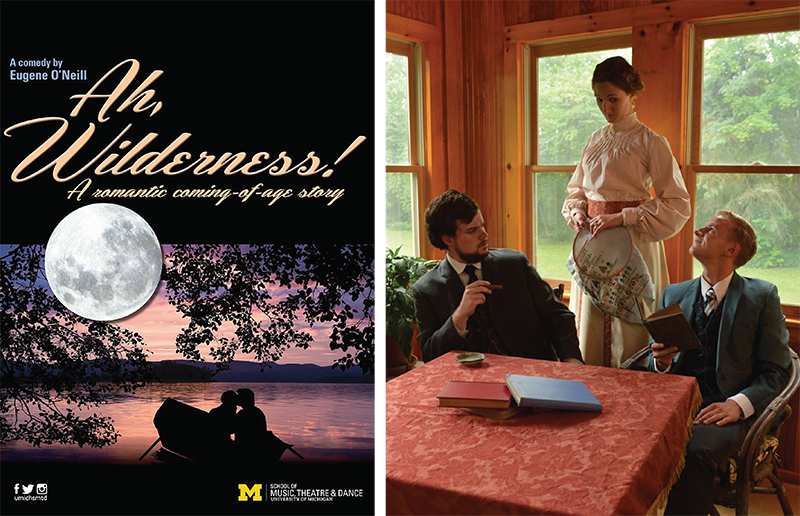
Ah, Wilderness! is an outlier among Eugene O’Neill’s plays, usually full of painful truth telling. It’s a summertime comedy, nostalgic for the youth the playwright never had. Its humor is soft and warm but it is also a quiet reflection on the limits of freedom, set appropriately on the Fourth of July.
The play offers two challenges to a university theater company. It is set in 1906, a time that O’Neill romanticizes as a period of innocence and propriety under assault, a time far removed from now. It is also a family play, in which most of the characters are younger or quite a bit older than the student actors.
The University of Michigan School of Music, Theatre and Dance cast under the direction of John Neville-Andrews tries hard to create a semblance of an early 20th century family but seems stiff, corseted in their roles and their interplay with each other. This play depends on that interplay, but in this production only a few scenes capture what O’Neill was about.
The Millers of a “large small town” in Connecticut are a solidly middle class clan. Father Nat is the owner of the local newspaper, his wife, Essie, is the dominant figure at home and a stickler for moral values. They have four children, Arthur, a Yale student; Mildred, a modern young woman; Richard, an emerging firebrand; and young Tommy, a firecracker in more ways than one.
Richard is the central character here. He’s a young man intoxicated by new, revolutionary ideas. He’s hiding his copies of Oscar Wilde, Bernard Shaw, Algernon Swinburne and Omar Khayyam. He’s also intoxicated with a girl named Muriel and trying out all he’s learned on her innocent person.
Another main character is Essie’s brother Sid. Uncle Sid is a cautionary tale, an alcoholic with a good heart and a crippling weakness. Sid is the object of Nat’s sister Lily’s affection and deep disappointment.
The Fourth is a holiday dedicated to celebrating a revolution and the ideas it helped take hold. But Richard is a classic naïf, a 16-year-old boy anxious to get on with becoming a man and ready to take that first step into naughty rebellion.
This production never settles into a comfortable give and take. The actors seem too often to be reciting and moving stiffly about. The gentle humor is often lost and the humor that is meant to be forced and awkward is never separated from all the rest. The actors seem to have trouble playing the middle aged characters authentically and fall back on stiff mannerisms of an earlier time. But there are good moments and solid effort.
Kevin Corbett gives Richard Miller the right amount of "gee whiz" enthusiasm for the swirl of ideas in his head and he has some good comic moments as he goes to the “dark side” in his encounter with a brassy lady of the night. But even he doesn’t quite capture the giddiness and fear of a boy on the cusp of manhood.
Larissa Marten has every bit the look of a strong matriarch as Essie. She’s tall with an attractive face made stern from admonishing her children. She also has a commanding voice. But her performance is stiff, missing the humor intended under what she says and posing too often. Essie is more than she seems as we see later in the play, but we get few suggestions of that early on.
Liam Loomer brings honest warmth to the role of Nat. He struggles to relax into a real middle-aged man and is forced into playing with cigars and pipes and too much joie de vivre. He does a fine bit of physical comedy in a scene with Corbett where he struggles to explain the “facts of life.” Loomer also has an uncanny resemblance to a young Orson Welles.
Oren Steiner probably has the hardest role in the play as Uncle Sid. Sid is a one-time valued newspaper reporter brought down by a weakness for alcohol. Despite his weakness, Sid is a lovable drunk, not the usual mess found in other O’Neill plays. Steiner does a good job of melding the two sides of Sid and brings some sweet interplay with his nephew Richard after Richard’s night out. But a lot of the humor that is sad/funny about Uncle Sid doesn’t come through and seems, again, stiff and labored.
Amy Aaron as the long-suffering Lily is fairly convincing but looks far too young for the part and lacks the nervousness that seems intended in a character defined as “poor spinster” forced to take shelter in her brother’s house while pining for desolate Sid.
Juliana Tassos plays the brassy prostitute with a nod to Mae West and a squawky voice. Morgan Waggoner is the ethereal Muriel. She gets the tension between desire and rectitude as the play becomes a poetic valentine.
A couple actors seem a bit more relaxed in their performances. Sarah Prendergast plays sister Mildred with a breezy good humor and no posed mannerisms. Eddie Williams as a shifty bartender is also natural as he seems to glide across the barroom.
Ah, Wilderness! was a sweet spot to which O’Neill never ventured again. His family plays in the future would be dark and brooding and even more revolutionary than Wilde, Shaw or Omar Khayyam. But even here he raised some real issues about the limits of freedom and the value of restraint when it comes in the warm embrace of a loving and upright family.
Hugh Gallagher has written theater and film reviews over a 40-year newspaper career and was most recently managing editor of the Observer & Eccentric Newspapers in suburban Detroit.
Ah, Wilderness! continues at the Arthur Miller Theatre on the North Campus of the University of Michigan at 7:30 p.m. Oct. 13, 8 p.m. Oct. 7,8,14 and 15 and 2 p.m. Oct. 9 and 16. For tickets, call (734)764-2538, go online to tickets.music.umich.edu or in person at the League Ticket Office in the Michigan League building at Fletcher and N. University.
Preview: Redbud Productions Presents 'Good People'
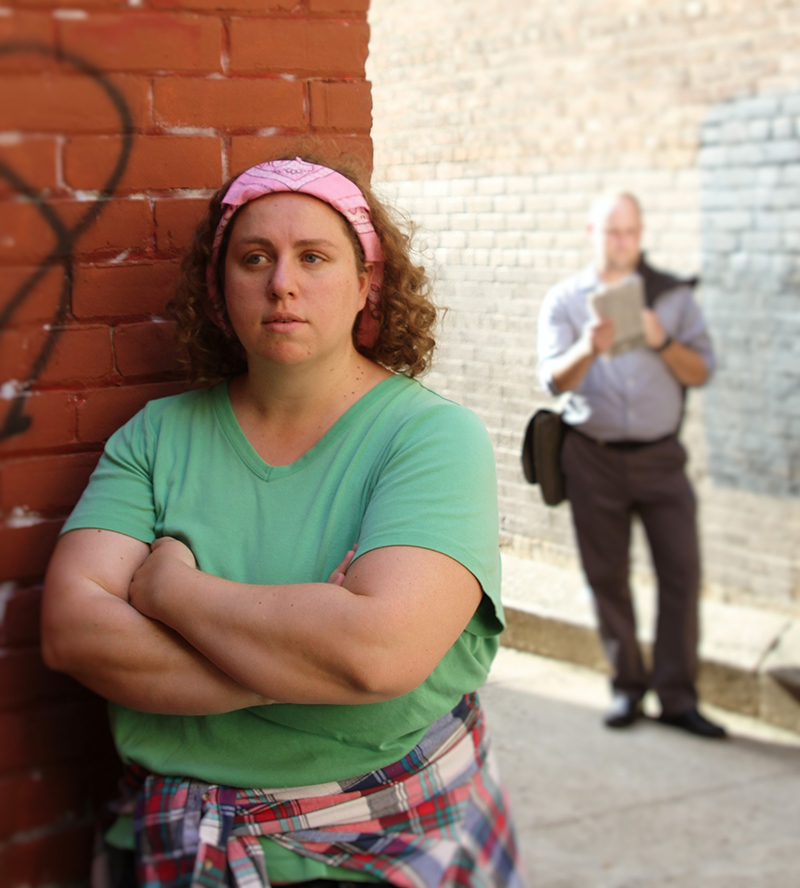
Redbud Productions celebrates its 18th year with the Tony-nominated comedy/drama Good People, a delightful play named Best Play of the Year by the New York Drama Critics’ Circle. From the writer of the Pulitzer Prize-Winning Rabbit Hole, David Lindsay-Abaire, Good People explores the struggles, shifting loyalties, and unshakable hopes that come with having next to nothing in America.
Welcome to Southie, the Boston neighborhood where a night on the town means a few rounds of bingo; where this month’s paycheck covers last month’s bills, and where Margie Walsh (Katie Whitney) has just been fired from yet another job.
Facing eviction from her eccentric landlady (Linda Lee Austin) and scrambling to catch a break, Margie, on the advice of her best friend (Emily Rogers), approaches her former boyfriend (Dave Barker), now a wealthy doctor, in hopes that he is her ticket to a fresh new start. Will this self-made man face his humble beginnings? Margie risks what little she has left to find out.
David Lindsay-Abaire’s play Rabbit Hole was honored with the Pulitzer Prize for Drama, five Tony Award nominations, and the Spirit of America Award. Good People premiered on Broadway and received two Tony Award nominations and the New York Drama Critics Circle Award for Best Play of the Year.
“Good People maps the fault lines of social class with a rare acuity of perception while also packing a substantial emotional wallop.” - Boston Globe “A wonderful new play … poignant, brave and almost subversive in its focus on what it really means to be down on your luck” - The New York Post
Amy Cantú is a Production Librarian at the Ann Arbor District Library.
Good People runs October 13-15 at the Kerrytown Concert House, 415 North Fourth Avenue, Ann Arbor. General Seating Tickets - $20 for adults; $15 for students (limited front row café table seating for groups of 2 - 3 for $25 a seat. For reservations, call Kerrytown Concert House at 734-769-2999 or visit http://kerrytownconcerthouse.com.
Review: "Mr. Joy" at Theatre Nova
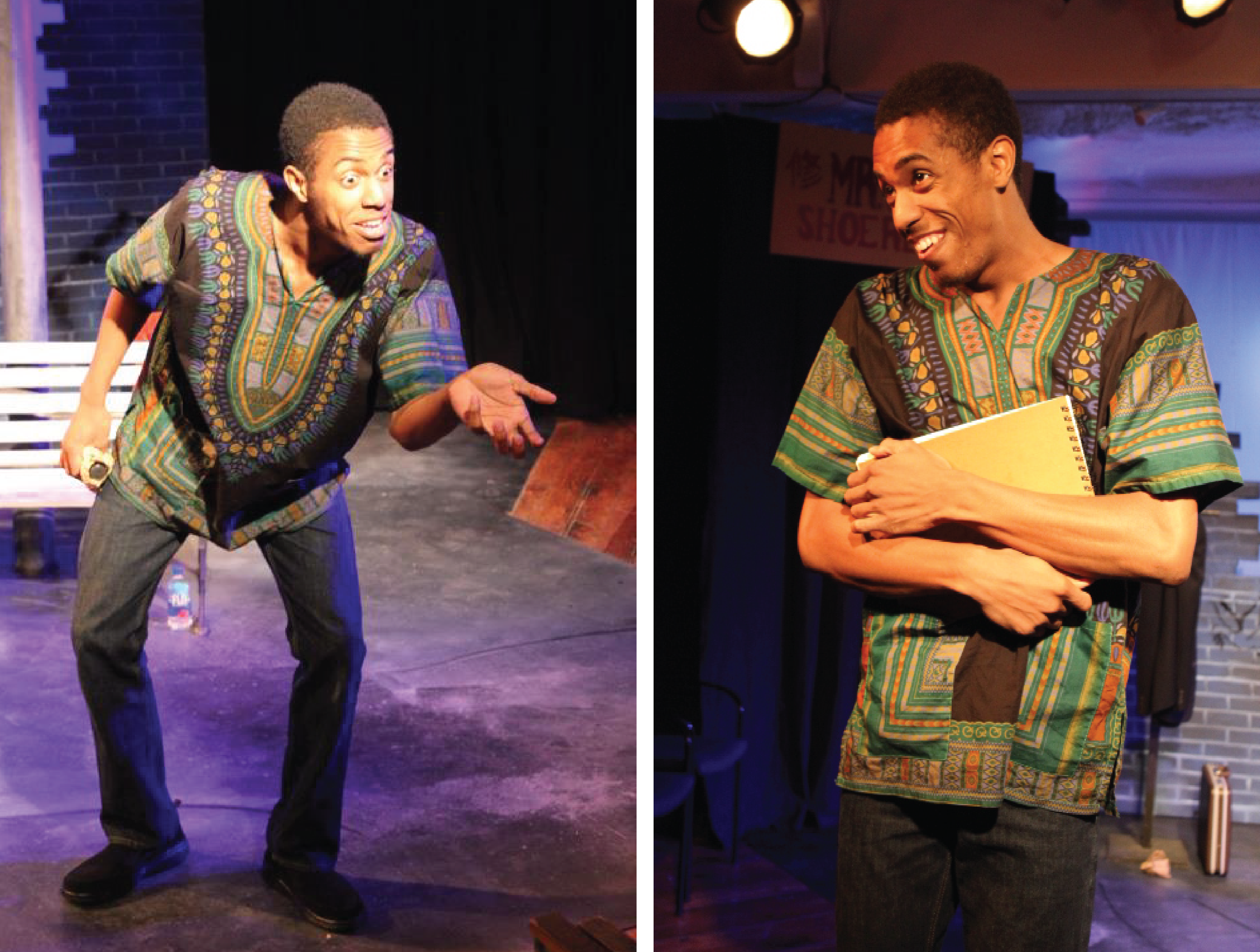
While watching Daniel Beaty’s play Mr. Joy at Theatre Nova, I immediately thought of Yong Kim, the owner of Mary’s Fabulous Chicken and Fish in Ann Arbor, who was robbed and brutally beaten with a plastic milk crate while walking to his car from the restaurant in 2014. Kim was 74 at the time of his attack, and the assailants turned out to be two teenage boys.
According to press reports, Kim managed to do something many of us would struggle mightily to do: he forgave his attackers.
Mr. Joy tells a similar story, through the prism of one actor playing several characters. In the play, longtime Harlem shoe repair shop owner Mr. Kim is robbed and beaten one night, but he won’t tell the police who his attacker was. And while Mr. Joy is the play’s nucleus, we never actually see him. Instead, we hear perspectives from those whose lives he’s touched: a homeless former painter; an 11 year old girl from the projects with AIDS, Clarissa, who considers herself his apprentice; Clarissa’s feisty grandmother; Clarissa’s schoolyard boyfriend, Peter; a young poet, DeShawn, who finds hope at church; Mr. Joy’s Ivy League-educated, real estate dealer son; the son’s rich, black Republican boss; the boss’ white girlfriend, who yearns for a child; and the boss’ transgender, flight attendant daughter, Ashes.
The hands-down best thing about Mr. Joy is seeing actor Matthew Webb embody each of the play’s characters with tremendous focus, care, and zeal. With an assist from director Billicia Hines’ guiding hand, Webb uses minimal costume changes and props – a notebook, a blazer and briefcase, a pair of red pumps, etc. – and efficient physical cues, like posture and gait, in addition to vocal inflection, to delineate the transitions between characters, and the effect is powerful. Despite the number of characters, and despite a couple of them earning a tenuous-at-best place in the narrative, Theatre Nova’s production never lacks clarity, and Webb’s performance is truly gripping to behold. (Those who previously saw the actor perform in TN’s I and Thou will leave Mr. Joy a much deeper appreciation for his talents and versatility.)
That said, Beaty’s play itself doesn’t provide much that’s bracing or new or thought-provoking regarding our ongoing national discussion of race, class, and inequality in America. Yes, there are moments of both sweetness and pain in the show; and DeShawn, in one scene, performs an impassioned performance poem that taps into the rage and fear and frustration of the community.
But we also hear familiar banalities from Grandma Bessie about faith, and how important it is to make the effort to talk to people; we see a character who will forever define himself by his own worst act – yet it’s hard to believe he even committed the crime, based on the short glimpses we’re shown of him, so the play’s “big reveal” feels instead like an unsatisfying, unearned authorial shortcut.
And finally, we have a politically conservative black man’s self-imposed estrangement from his child, born a son, because he chooses to undergo surgery to become a woman. This level of emotional complexity demands a play unto itself, frankly, in order to really dig into the issues involved; getting the drive-by version inevitably falls short.
Set designer Kelsey Nowak keeps things simple, with a busted brick wall backdrop (in front of a screen for occasional projections), a bench, milk cartons, a stool, a coat stand, a store sign, and a raised corner for Mr. Joy’s regular customers to leave shoes as a kind of prayer for his recovery. Daniel C. Walker lights the show beautifully, signaling character and mood transitions. And costume designer Carla Milarch (who also designed the show’s sound) found clothes that were neutral, but also wholly appropriate, for Webb to wear as he navigates between a broad variety of characters.
I’ll confess Theatre Nova’s design elements, paired with Webb’s powerhouse performance, had me seduced as the lights came up; but the more I thought (and wrote) about the play, the more I couldn’t overlook the script’s shortcomings. For unlike Ta-Nehisi Coates’ invigorating, harrowing, brutally honest book Between the World and Me – a letter to Coates’ son about growing up as an endangered black man in America – Mr. Joy never takes the risks necessary to push us into new, uncharted territory in regard to talking about race; and that’s precisely where we need to go if anything’s going to change.
Jenn McKee is a former staff arts reporter for The Ann Arbor News, where she primarily covered theater and film events, and also wrote general features and occasional articles on books and music.
Mr. Joy runs through October 23 at the Yellow Barn, 410 W Huron St, Ann Arbor. Visit https://www.artful.ly/theatre-nova/store/events for tickets.
No Tickets Needed: A Free Dose of Culture

Ann Arbor is a city that has plenty to offer, but sometimes the cultural highlights may be a *little* beyond the budget for those of us who may not have the most regular of paychecks. So for those of you who are looking for an arts experience while still saving $$$, look no further! This piece of blog is here to share the local arts events you can attend FOR FREE!
The University of Michigan’s School of Music, Theater, and Dance is a great source of low-or-no-cost access to displays of incredible talent. The UM-SMTD events calendar, lists concerts, lectures, and master classes taught by visiting instructors or guest faculty. This calendar has a $ symbol on events that have a cost, but thankfully those symbols are few and far between.
Earlier this month, I participated in an open-to-anyone master class led by a guest instructor in the dance program. I arrived and grabbed a seat, which turned out to be right beside the guest speaker, Anita Gonzalez. This was less awkward than it might have been because she was soon on the floor, warming up with the rest of the dancers. Gonzalez called the class to attention as the dancers stretched and flexed and effortlessly made shapes with their bodies. As she led activities, she explained the connection between breath, voice, and movement. Eventually, the dancers created moving historical vignettes of African American slaves working in the fields, with lumber, or on the railroads – singing the songs that kept them from despair and connecting them through their common goal of freedom. It was amazing to watch.
But wait, there’s more! The art of the written word is celebrated almost every day of the week at Literati Bookstore on Washington St! Just a few weeks ago I attended a (free!) reading at Literati of the new fiction bestseller The Nix by author Nathan Hill.
The Nix is Hill's first book that the Literati emcee described as “deceptively simple” but with the excitement of a “choose your own adventure story.” The major selling point for me was the claim that it was “a big book that reads fast.” Once Hill took the podium in that second floor Espresso Bar space, he explained The Nix was 10 years in the making, and once he started reading from the work, I had to agree that it was 10 years well spent. The reading he selected was from a chapter in which a student in the protagonist's logic class manages to include all 16 types of fallacy as they argue for a better grade.
The chapter is hilarious; my cheeks hurt by the end of the night from constantly smiling. Hill’s main character comes across as well-educated and flawed in relatable ways that make you want to keep reading. In this chapter, Hill also features a run-on sentence of epic proportions which required him to fortify himself with a drink water before reading it. It was truly a delight to hear this new author read, and I encourage readers to get their hands on a copy if only to discover why the words “aluminum” and “nuther” are so laughable.
Literati has tons of events, so check their calendar often to stay up to date. It is usually only their "ticketed events” that have an associated cost - most Literati events don’t cost a dime!
Liz Grapentine is a desk clerk at AADL. A graduate from Oakland University with a major in Music Education and a minor in English, Liz enjoys all the arts in every form. Liz is also a true Ann Arbor townie and a proud patron of the library since 1995.
Review: Encore’s Full Monty delivers laughs and quiet emotions
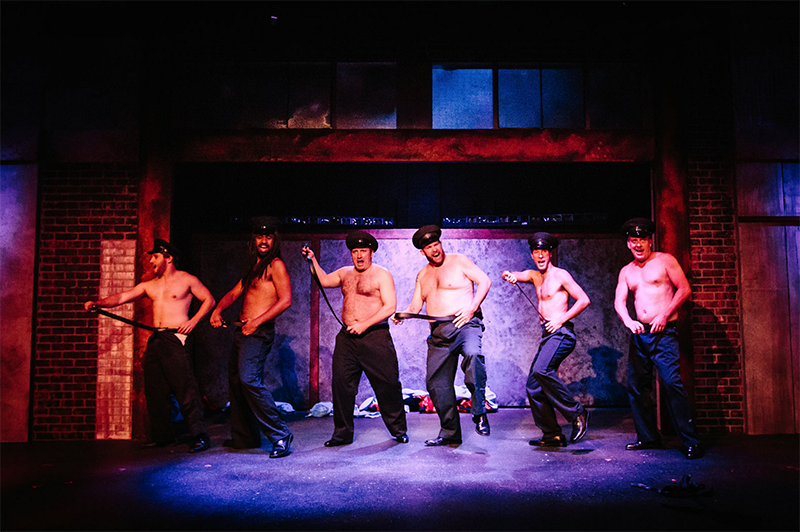
The Encore Musical Theatre Company is taking it all off and going the Full Monty for a lot of laughs and a bit of introspection.
The 1997 movie The Full Monty was part of a long tradition of British comedies with a biting social message. It was hilariously funny and a bit naughty but it was also at times a poignant and carefully observed view of a steel town, Sheffield, England, in the throes of yet another economic downturn.
In 2000 playwright Terrence McNally moved the story from England to equally downtrodden Buffalo, New York, and replaced the lively Top 40 R&B soundtrack with an original score with lyrics and music by David Yazbeck. The musical doesn’t have the grit or the deeper sense of class alienation of the movie, but it does have a nice blend of good humor, touching drama, and a bright jazzy score, which Encore brings beautifully to life.
Jerry Lukowski and Dave Bukatinsky are recently unemployed steel workers. Jerry is divorced, behind in his child support and afraid of losing contact with his middle-school-aged son. Dave is overweight, uneasy with his body and his life. After seeing the excitement created by a Chippendales-style strip show among the local women, Jerry decides that they should create their own show with dreams of making $50,000 and getting their lives back in order. Knowing their bodies would not be a lure, Jerry tells some local women that they will go the full monty, totally nude.
This production gets off to a great start by having two excellent actors in the lead roles. Eric Parker as Jerry brings energy, a bit of self-conscious swagger, and a sensitive change from macho to humane. Parker makes Jerry a full human being in search of who he really is. He isn’t a great singer but he gives real authority to tough songs like "Scrap," comic songs like "Big Ass Rock" and the gentle reflection of "Breeze Off the River," a love song to his sleeping son.
Greg Bailey’s Dave is a lumpish, dragging, sad-eyed mess as Dave. He’s good-hearted but unhappy with his body, his discomfort in what should be a happy marriage, and his loss of a job. Bailey captures just the right amount of languor and hangdog expression to make his transformation toward the end all the more triumphant.
The entire ensemble gives it their all. Dan Morrison is Harold, the laid off manager with the expensive wife. Morrison gives the character a nervous energy that goes from unease to “what the heck” let’s do it charm. Matthew Pecek is the mama’s boy Malcolm and he first appears as a suicidal mess, his thin body tightly wrapped, and then he opens up as he finds himself and love. Pecek, also, has a fine singing voice.
Jordan Harris plays Horse, a black man with the dance skills. Harris brings some extra zip to the dance numbers and some sly comedy when dealing with a certain black stereotype. The last member of the dance group is Ethan, a man obsessed with Donald O’Connor’s ability to climb walls and possessing a special asset for a stripper. Brendan Kelly is funny and also brings a good singing voice to his duet with Pecek.
Gayle Martin is Jeanette, the tough talking piano accompanist who has seen it all and played for the best of them (or so she says). Martin has some great lines, which she delivers with deadpan perfection.
A wilder bit of comedy is served up by the rubber-faced Sarah Briggs who plays Harold’s money loving wife. Briggs is a gifted comic actress who lights up the stage on "Life With Harold," a rollicking affirmation of love, and lets it all out in a later scene where her love shines through.
Alejandro Cantu has the difficult role of Nathan, Jerry’s long-suffering son. He loves his dad and his mom and he kind of likes his mom’s nerdy boyfriend. Cantu is a young actor who understands these conflicting emotions and just what they can do to you. His performance is direct, sensitive, and never “cute.”
In the small role of Keno, a studly Chippendales dancer, Colby Orton proves charming and captures the dancer’s sincere good intentions.
Thalia V. Schramm, who co-directed with Matthew Brennan, does double duty as Dave’s concerned wife, and provides the right amount of warmth when things get low.
Schramm and Brennan keep the comedy within the range of reality enough to make the serious moments have resonance. This is a comedy with serious content, from body image to economic justice to the plight of divorced fathers, and it plays them with some degree of respect.
Brennan is also the choreographer and he has the chore of directing some deliberately bad choreography in the beginning and then a triumphant Act One closer on "Michael Jordan’s Ball," a dance inspired by the great Bulls forward.
The small ensemble under musical director R. Mackenzie Lewis gives fine support from their perch. Yazbek’s score is serviceable, with some jazzy moments and a lively "Let it Go" ensemble number at the giddy and satisfying ending.
This is not a show for everyone. It has some rough language and bared backsides. But the end result is not raunchy and the music and story are upbeat.
Hugh Gallagher has written theater and film reviews over a 40-year newspaper career and was most recently managing editor of the Observer & Eccentric Newspapers in suburban Detroit.
The Full Monty continues at the Encore Musical Theatre, 3126 Broad Street in Dexter through Oct. 22. For times and ticket information, call the Encore Theatre Box Office at (734) 268-6200 or visit http://www.theencoretheatre.org.
Review: The TEAM's "RoosevElvis," presented by UMS
One unforgiving truth of fame is that when you become larger-than-life, you’re also conversely diminished, so as to seem elusively inhuman.
Brooklyn-based The TEAM’s experimental theater production RoosevElvis, now playing in Ann Arbor by way of University Musical Society, begins with a scene that illustrates this very point. Theodore Roosevelt (Kristen Sieh) and Elvis Presley (Libby King) sit next to one another in director’s chairs, sharing a microphone between them as they take turns voicing odd autobiographical facts and anecdotes.
Significantly, the back-and-forth doesn’t feel like two competitors trying to one-up each other – yes, Roosevelt stridently brags, but Elvis isn’t intimidated, blithely contributing his more modest memories with a laid back slouch. In this way, the exchange illustrates key differences between the two icons of American masculinity.
Sieh, decked out in Roosevelt’s trademark facial hair and glasses, as well as a fringed cowhide suit (Sieh designed the shows costumes as well), employs a sharp patrician delivery that echoes Katherine Hepburn. We hear about Harvard, and how he won an election at age 23. “What a great story,” she says often, congratulating herself.
King, as Elvis, wears blue suede shoes (of course), jeans, a white T-shirt, and a red, short-sleeved button down shirt, topped with a modest Elvis wig, of course. Far more retiring and relaxed than Roosevelt, Elvis talks about being an only child, moving to Memphis, and hearing his first record played nine times in a row on the radio.
But after this introduction, the green screen behind them disappears to reveal the drab apartment of Ann (King), a shy, lonely, 35 year old meat-packing plant employee in Rapid City, South Dakota. (During the transition, you see video footage of her at her workplace.) As Ann, King enters the apartment with a 6 pack, drinks a beer, and engages in a one-person conversation between herself and her idol, Elvis, about having, for the first time, connected with a woman via the Internet. Soon Brenda (Sieh), as a self-assured taxidermist who’s in town for a conference, emerges wrapped in an Elvis towel from the bathroom.
So yes, it takes a few minutes to get your bearings while watching RoosevElvis – and, fair warning, you likely never will completely. But that’s the aim of experimental work, of course. You have to let go of the desire/expectation for linearity and absorb all the ideas and trippy images that are playing out in front of you on stage.
Even so, there is at least a loose narrative at the center of RoosevElvis: Ann’s hopeful, extended date with Brenda – a Roosevelt fan, not coincidentally – turns sour as the two women take a road trip to the Badlands, including stops at Mt. Rushmore and Wall Drug. Though the show relies a bit too heavily on Andrew Schneider’s backdrop videos, the clips are often used in interesting ways. For instance, when Ann recoils from Brenda’s sexual candor in a diner, two video screens show the two women eating their meal in silence, thus underscoring the fact that what began as a hopeful adventure into love has ended in an uncomfortable, miserable stalemate.
Roosevelt and Elvis appear to have earned a place in Ann’s psyche because they embody ideals of masculinity, and as a woman who wears men’s Y-front briefs, and feels like “one of the guys” among the men working at her side at the meat packing plant, Ann is working through who she is, and whom she wants to be. Plus, her rough break-up with forthright, Roosevelt-like Brenda, who calls her “un-brave,” rattles her enough to drive her to take a solo trip to Graceland. Along the way, she leaves Roosevelt and Elvis behind in a hotel room, which they know bodes well for Ann; but when left with just each other, they clash and criticize each other, exiting with the classic line, “Let’s take this outside.”
There are many other delightful, strange, surprising moments in RoosevElvis, wittily directed by Rachel Chavkin: Sieh’s Roosevelt ballet, in which a gentle, beautiful grace is combined with showy muscle-flexing; a sudden, one-off Ann-Margaret moment; Roosevelt pulling on boxing gloves and calling for a TEAM member to start the footage from “Planet Earth,” so that he may punch at the bison individually on-screen (hysterical); Sieh’s funny, uncanny portrayal of a Spirit Airlines representative, urging Ann to stay on hold; the thoughtful use of rowing machines as a set piece (the set was designed by Nick Vaughan); and a Thelma & Louise tie-in that’s far more than a pop culture wink.
But King is the show’s emotional core, and she delivers a dignity, a humility, and a hunger that’s palpable, both in Elvis and Ann. That’s not to say that every part of the show hits its mark. With a running time of just over 90 minutes, the show feels oddly labored after a while, particularly following Brenda and Ann’s final, bracing phone conversation. And there’s a brief scene in which King and Sieh transform into diner waitresses for just a moment – and I still don’t know what purpose that served.
That’s OK, though. When an innovative theatrical company like The TEAM goes on an adventure and asks you to come along, I think it’s mostly worth the bumps in the road to experience the ride.
Jenn McKee is a former staff arts reporter for The Ann Arbor News, where she primarily covered theater and film events, and also wrote general features and occasional articles on books and music.
RoosevElvis runs through Saturday, October 1, at the Lydia Mendelssohn Theatre, 911 N. University Ave. Visit http://ums.org/performance/roosevelvis/ for more information and tickets, or call 734-764-2538.


